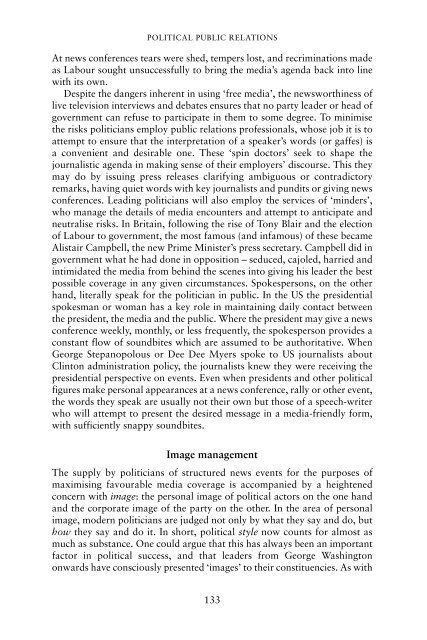20130412164339753295_book_an-introduction-to-political-communication
20130412164339753295_book_an-introduction-to-political-communication
20130412164339753295_book_an-introduction-to-political-communication
Create successful ePaper yourself
Turn your PDF publications into a flip-book with our unique Google optimized e-Paper software.
POLITICAL PUBLIC RELATIONS<br />
At news conferences tears were shed, tempers lost, <strong>an</strong>d recriminations made<br />
as Labour sought unsuccessfully <strong>to</strong> bring the media’s agenda back in<strong>to</strong> line<br />
with its own.<br />
Despite the d<strong>an</strong>gers inherent in using ‘free media’, the newsworthiness of<br />
live television interviews <strong>an</strong>d debates ensures that no party leader or head of<br />
government c<strong>an</strong> refuse <strong>to</strong> participate in them <strong>to</strong> some degree. To minimise<br />
the risks politici<strong>an</strong>s employ public relations professionals, whose job it is <strong>to</strong><br />
attempt <strong>to</strong> ensure that the interpretation of a speaker’s words (or gaffes) is<br />
a convenient <strong>an</strong>d desirable one. These ‘spin doc<strong>to</strong>rs’ seek <strong>to</strong> shape the<br />
journalistic agenda in making sense of their employers’ discourse. This they<br />
may do by issuing press releases clarifying ambiguous or contradic<strong>to</strong>ry<br />
remarks, having quiet words with key journalists <strong>an</strong>d pundits or giving news<br />
conferences. Leading politici<strong>an</strong>s will also employ the services of ‘minders’,<br />
who m<strong>an</strong>age the details of media encounters <strong>an</strong>d attempt <strong>to</strong> <strong>an</strong>ticipate <strong>an</strong>d<br />
neutralise risks. In Britain, following the rise of Tony Blair <strong>an</strong>d the election<br />
of Labour <strong>to</strong> government, the most famous (<strong>an</strong>d infamous) of these became<br />
Alistair Campbell, the new Prime Minister’s press secretary. Campbell did in<br />
government what he had done in opposition – seduced, cajoled, harried <strong>an</strong>d<br />
intimidated the media from behind the scenes in<strong>to</strong> giving his leader the best<br />
possible coverage in <strong>an</strong>y given circumst<strong>an</strong>ces. Spokespersons, on the other<br />
h<strong>an</strong>d, literally speak for the politici<strong>an</strong> in public. In the US the presidential<br />
spokesm<strong>an</strong> or wom<strong>an</strong> has a key role in maintaining daily contact between<br />
the president, the media <strong>an</strong>d the public. Where the president may give a news<br />
conference weekly, monthly, or less frequently, the spokesperson provides a<br />
const<strong>an</strong>t flow of soundbites which are assumed <strong>to</strong> be authoritative. When<br />
George Step<strong>an</strong>opolous or Dee Dee Myers spoke <strong>to</strong> US journalists about<br />
Clin<strong>to</strong>n administration policy, the journalists knew they were receiving the<br />
presidential perspective on events. Even when presidents <strong>an</strong>d other <strong>political</strong><br />
figures make personal appear<strong>an</strong>ces at a news conference, rally or other event,<br />
the words they speak are usually not their own but those of a speech-writer<br />
who will attempt <strong>to</strong> present the desired message in a media-friendly form,<br />
with sufficiently snappy soundbites.<br />
Image m<strong>an</strong>agement<br />
The supply by politici<strong>an</strong>s of structured news events for the purposes of<br />
maximising favourable media coverage is accomp<strong>an</strong>ied by a heightened<br />
concern with image: the personal image of <strong>political</strong> ac<strong>to</strong>rs on the one h<strong>an</strong>d<br />
<strong>an</strong>d the corporate image of the party on the other. In the area of personal<br />
image, modern politici<strong>an</strong>s are judged not only by what they say <strong>an</strong>d do, but<br />
how they say <strong>an</strong>d do it. In short, <strong>political</strong> style now counts for almost as<br />
much as subst<strong>an</strong>ce. One could argue that this has always been <strong>an</strong> import<strong>an</strong>t<br />
fac<strong>to</strong>r in <strong>political</strong> success, <strong>an</strong>d that leaders from George Washing<strong>to</strong>n<br />
onwards have consciously presented ‘images’ <strong>to</strong> their constituencies. As with<br />
133
















